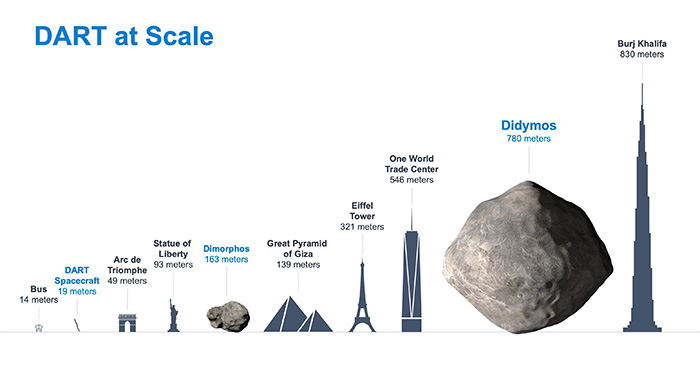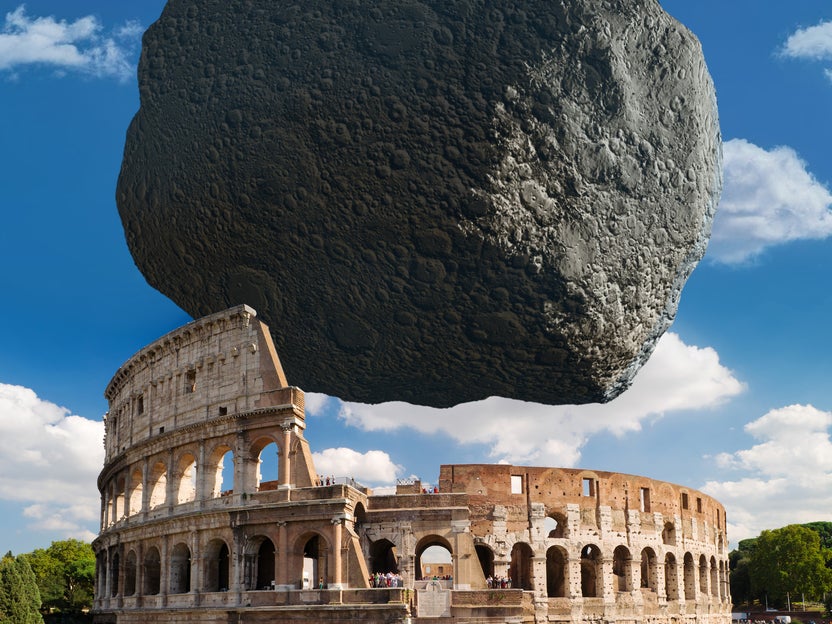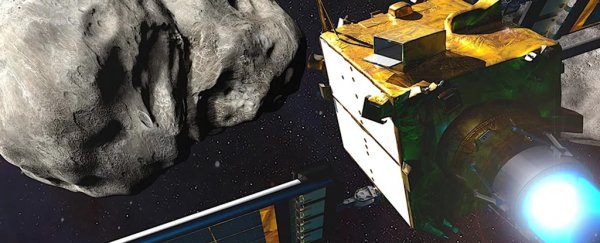NASA is about to launch a new space probe on a long journey to self-destruction.
The mission, called the Double Asteroid Redirection Test (DART), is sending a spacecraft traveling nearly 7 million miles to slam itself into an asteroid. The probe, a 4-foot (1.22 m) wide box, is a pebble compared to the enormous Colosseum-sized asteroid it's aiming for. But the impact should give the space rock enough of a nudge to change its path orbiting a larger asteroid.
NASA is testing whether such a nudge could one day divert a rogue space rock headed for Earth. Scientists don't currently know of any dangerous Earth-bound asteroids, but NASA estimates that they have only spotted about 40 percent of asteroids near Earth that are 140 meters (450 feet) or larger. Such an asteroid could level an entire city.
 (ESA Science Office)
(ESA Science Office)
DART is a two-pronged test of a planetary-defense method, according to Tom Statler, a NASA astrophysicist working on the mission.
"The first test is testing our technological ability to hit the asteroid. And the second test is testing the response of a real asteroid to being hit. The first test ends and the second test starts at the moment that the spacecraft is smashed to bits," Statler told Insider.
The asteroid's response to the impact will help NASA determine how large future probes should be in order to move their targets.
DART is set to begin its journey at 1:20 am ET (0620 UTC) on Wednesday, lifting off from Vandenberg Space Force Base, California, aboard a SpaceX Falcon 9 rocket. If all goes according to plan, it will reach its destination in September 2022.
NASA is livestreaming the launch on YouTube, starting at 12:30 am ET (0530 UTC) on Wednesday. Watch, below:

NASA could save Earth from a city-killing asteroid – with 5 to 10 years' advanced notice
For 10 months, DART will speed toward a pair of asteroids. One, a moonlet called Dimorphos, orbits the other, Didymos. DART is aiming for the moonlet. At 525 feet (160.02 m) wide, it's much smaller than its 2,500-foot (762.00 m) companion.
Neither Didymos nor Dimorphos poses a threat to Earth. But they're ideal for testing what NASA calls the "kinetic impactor" method – crashing a spacecraft into an asteroid at high speeds to nudge it in a different direction.
It's a tricky feat, given that DART won't be able to see Dimorphos until an hour before impact. But NASA engineers have programmed the spacecraft to quickly calculate the asteroid's center and steer itself towards that point.
The spacecraft should hit Dimorphos's center at 15,000 miles (24,140 km) per hour (4 miles (6 km) per second), transferring its kinetic energy to the asteroid and pushing it closer to Didymos.
NASA estimates that the impact will cause an explosion of between 22,000 and 220,000 pounds (99,790 kg) of rock material, which could give it an even bigger push than DART itself. In the end, Dimorphos should orbit the larger rock at least 73 seconds faster than before.
Although the impact will occur about 6.8 million miles from Earth, astronomers will be watching with their telescopes to see the asteroid's orbit change.
 The 160-m diameter Dimorphos asteroid compared to Rome's Colosseum. (ESA-Science Office)
The 160-m diameter Dimorphos asteroid compared to Rome's Colosseum. (ESA-Science Office)
If the method works, it could one day save Earth from a city-killing asteroid. But there's a catch. In order to use a DART-like mission to divert such a threat, experts previously told Insider, NASA probably needs about five to 10 years' advanced notice of an Earth-bound asteroid.
That's because it takes years to design and build a spacecraft, then months or years to travel to the asteroid. What's more, the probe would likely need to hit an asteroid a year or two before its orbit intersects with Earth. The slight nudge of a spacecraft impact would only take the rock slightly off course at first. But over time, that change would carry it away from Earth.
In order to identify hazardous asteroids with enough lead time, NASA is building a space telescope called Near-Earth Object Surveyor to monitor asteroids 140 meters or larger. Right now astronomers have identified an estimated 40 percent of such asteroids that orbit the sun near Earth, but NASA hopes the telescope will bring that catalogue up to 90 percent.
Astronomers on Earth will quickly be able to see whether DART worked. Then the European Space Agency plans to launch a follow-up mission, called Hera, to examine Didymos and Dimorphos in 2026. Hera will study the aftermath of the impact.
It's set to map Dimorphos, precisely measure its mass, and examine the crater that DART leaves there.
This article was originally published by Business Insider.
More from Business Insider:
